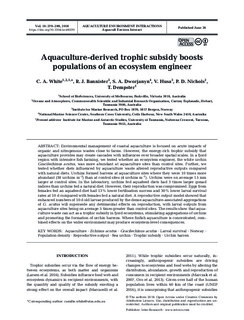Aquaculture-derived trophic subsidy boosts populations of an ecosystem engineer
White, Camille; Bannister, Raymond; Dworjanyn, Simon; Husa, Vivian; Nichols, Peter D.; Dempster, Tim
Journal article, Peer reviewed
Published version

View/
Date
2018Metadata
Show full item recordCollections
- Articles [3001]
- Publikasjoner fra CRIStin [3023]
Abstract
Environmental management of coastal aquaculture is focused on acute impacts of organic and nitrogenous wastes close to farms. However, the energy-rich trophic subsidy that aquaculture provides may create cascades with influences over broader spatial scales. In a fjord region with intensive fish farming, we tested whether an ecosystem engineer, the white urchin Gracilechinus acutus, was more abundant at aquaculture sites than control sites. Further, we tested whether diets influenced by aquaculture waste altered reproductive outputs compared with natural diets. Urchins formed barrens at aquaculture sites where they were 10 times more abundant (38 urchins m-2) than at control sites (4 urchins m-2). Urchins were on average 15 mm larger at control sites. In the laboratory, urchins fed aquafeed diets had 3 times larger gonad indices than urchins fed a natural diet. However, their reproduction was compromised. Eggs from females fed an aquafeed diet had 13% lower fertilisation success and 30% lower larval survival rates at 10 d compared with females fed a natural diet. A reproductive output model showed that enhanced numbers of 10 d old larvae produced by the dense aquaculture-associated aggregations of G. acutus will supersede any detrimental effects on reproduction, with larval outputs from aquaculture sites being on average 5 times greater than control sites. The results show that aquaculture waste can act as a trophic subsidy in fjord ecosystems, stimulating aggregations of urchins and promoting the formation of urchin barrens. Where finfish aquaculture is concentrated, combined effects on the wider environment may produce ecosystem-level consequences.